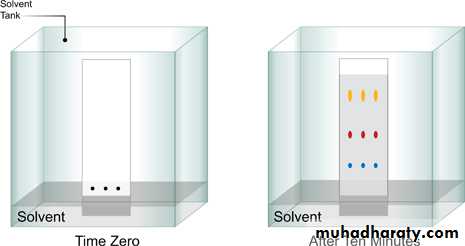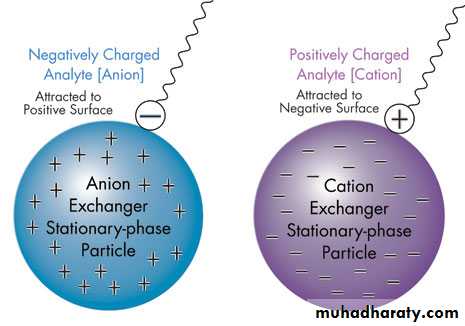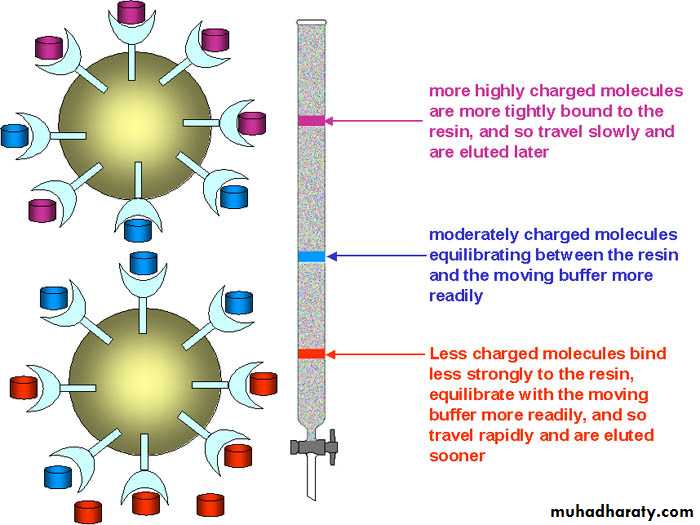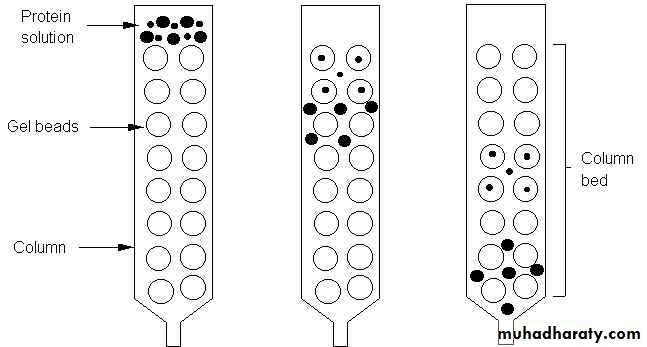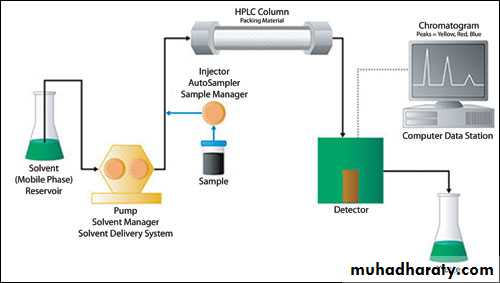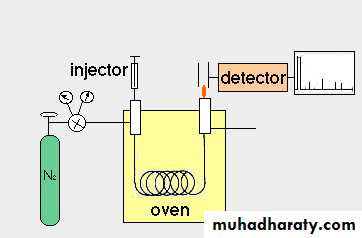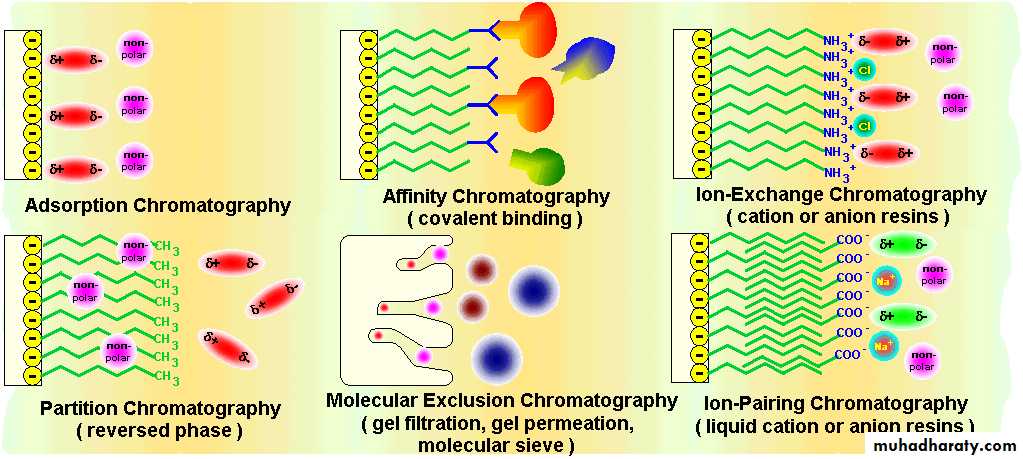Biochemistry for Medics www.namrata.co
CHROMATOGRAPHY1
Biochemistry of Medics
The word Chromatography is derived fro two Greek words –Chroma means – colour and graphein to write. Chromatography is the collective term for a family of laboratory techniques for the separation of mixtures.
Chromatography
2
Biochemistry of Medics
Chromatography, literally "color writing", was used—and named— in the first decade of the 20th century, primarily for the separation of plant pigments such as chlorophyll. New forms of chromatography is useful for a wide range of separation processes and chemical analysis tasks, especially in biochemistry. Chromatography is a misnomer since it is no longer limited to the separation of the colored substances.
Chromatography
3
Biochemistry of Medics
Chromatography is based on the principle of the partition of the solute between two phases/solvents. Chromatography usually consists of a mobile phase and a stationary phase. 1) The mobile phase usually refers to the mixture of the substances to be separated dissolved in a liquid or a gas. 2) The stationary phase is a porous solid matrix through which the sample contained in the mobile phase percolates. The interaction between the mobile and the stationary phases result in the separation of the compounds from the mixture. 3) These interactions include the physico chemical principles such as the adsorption, ion- exchange, molecular sieving and affinity.
Chromatography- Principle
4
Biochemistry of Medics
Two ways to classify methodology of chromatography:1)Based on interactions between sample component and stationary phase:i) Partitionii) Adsorptioniii) Ion-exchangeiv)Gel-filtrationv) Affinityvi)High performance liquid chromatography
Chromatography- Classification
5
Biochemistry of Medics
b) Base on nature of stationary phase or mobile phaseIt is of two typesi) Planar- It may be Paper or Thin layerii)Column- it may be Gas or Liquid Planar chromatography is a separation technique in which the stationary phase is present as or on a plane.Column chromatography is a separation technique in which the stationary bed is within a tube.
Chromatography- Classification(Contd.)
6
Biochemistry of Medics
It is used for the separation of mixture of amino acids and peptides. The molecules of a mixture get partitioned between the stationary and the mobile phase depending on the relative affinity of each one of the phases.It is undertaken in two ways:1) Paper chromatography2) Thin layer chromatography
Partition Chromatography
7
Biochemistry of Medics
-An analytical technique for the separation and identifying mixtures that are either coloured or can be made coloured-It is a liquid partition chromatography-Used for separation of amino acids, sugars, sugar derivatives & peptides
Paper chromatography
8
Biochemistry of Medics
1) The stationary phase is water held on a solid support of filter paper (cellulose). 2) The mobile phase is a mixture of immiscible solvents which are mixtures of water, a non polar solvent and an acid or base.e.g.Butanol, acetic acid water or phenol-water-ammonia.
Paper chromatography
9
Biochemistry of Medics
1) A small spot of sample is applied to a strip of chromatography paper about two centimeters away from the base of the plate. This sample is absorbed onto the paper and may form interactions with it. 2)The paper is then dipped in to a suitable solvent, such as ethanol or water, taking care that the spot is above the surface of the solvent, and placed in a sealed container. 3) The solvent moves up the paper by capillary action and dissolves the sample mixture, which will then travel up the paper with the solvent solute sample.
Paper chromatography- Procedure
10
Biochemistry of Medics
-Different compounds in the sample mixture travel at different rates due to differences in solubility in the solvent, and due to differences in their attraction to the fibers in the paper. -Paper chromatography takes anywhere from several minutes to several hours
Paper chromatography- Procedure
11
Biochemistry of Medics
Ascending ChromatographyIn this method, the solvent is in pool at the bottom of the vessel in which the paper is supported. It rises up the paper by capillary action against the force of gravity.Descending ChromatographyIn this method, the solvent is kept in a trough at the top of the chamber and is allowed to flow down the paper. The liquid moves down by capillary action as well as by the gravitational force. Substances that cannot be separated by ascending method, can be separated by the above descending method.
Ascending and Descending Paper Chromatography
12
Biochemistry of Medics
After development, the spots corresponding to different compounds may be located by their color, ultraviolet light, ninhydrin or by treatment with iodine vapors. The paper remaining after the experiment is known as the Chromatogram.The components which have been separated differ in their retention factor i.e Ratio of distance traveled from the spot or origin by the solute component to that of the distance traveled from the spot or origin by the solvent.
Paper Chromatography -Analysis
13
Biochemistry of Medics
Rf, Distance traveled by sample/ distance traveled by solvent.If Rƒ value of a solution is zero, the solute remains in the stationary phase and thus it is immobile. If Rƒ value = 1 then the solute has no affinity for the stationary phase and travels with the solvent front. Retention Factor can never be greater than one.
Rƒ value
14
Biochemistry of Medics
Sometimes, it is difficult to separate a complex mixture of substances by a single run with one solvent system. In such a case, a second run is carried out by a different solvent system, in a direction perpendicular to the first run. This is referred to as- two dimensional chromatography which enhances the separation of a mixture in to individual components.
Two dimensional chromatography
15
Biochemistry of Medics
1) Paper chromatography is a very easy, simple, rapid and highly efficient method of separation.2) Can be applied even in microgram quantities of the sample.3)Can also be used for the separation of a wide variety of materials like amino acids, oligopeptides, sugars, oligosaccharides, glycosides, purines and pyrimidines, steroids, vitamins and some alkaloids like penicillin, tetra cyclin and streptomycin.4) Not preferred for separating proteins because they are not soluble in many of the solvent systems and are also denatured by them. 5) Paper chromatography is inferior to thin layer chromatography in resolving power.
Significance of Paper chromatography
16
Biochemistry of Medics
-It is a chromatographic technique used to separate mixtures. -It involves a stationary phase consisting of a thin layer of adsorbent material, usually silica gel, aluminium oxide, or cellulose immobilized onto a flat, inert carrier sheet. -A liquid phase consisting of the solution to be separated which is dissolved in an appropriate solvent and is drawn up the plate via capillary action, separating the solution based on the polarity of the components of the compound in question.
Thin layer chromatography (TLC)
17
Biochemistry of Medics
-The process is similar to paper chromatography with the advantage of faster runs, better separations, and the choice between different stationary phases. -A small spot of solution containing the sample is applied to a plate, about one centimeter from the base. The plate is then dipped in to a suitable solvent, such as hexane or ethyl acetate, and placed in a sealed container. The solvent moves up the plate by capillary action and meets the sample mixture, which is dissolved and is carried up the plate by the solvent.- Different compounds in the sample mixture travel at different rates due to the differences in their attraction to the stationary phase, and because of differences in solubility in the solvent.
TLC- Procedure
18
Biochemistry of Medics
TLC -Overview
19
Biochemistry of Medics
Its wide range of uses include-determination of the pigments a plant contains-detection of pesticides or insecticides in food-identifying compounds present in a given substance-monitoring organic reaction
Significance of TLC
20
Biochemistry of Medics
1) In case of paper chromatography , it takes 14-16 hrs for the separation of the components, but in TLC, It takes only 3-4 hrs.2) TLC has the advantage that the corrosive reagents like sulphuric acid can also be used which pose a limitation for the paper chromatography.3) It is easier to separate and visualize the components by this method.4) It has the capacity to analyze multiple samples in a single run.5) It is relatively a low cost.
Advantages of TLC over paper chromatography
21
Biochemistry of Medics
-In this technique the separation is based on differences in adsorption at the surface of the solid stationary medium. -The adsorbents such as silica gel, charcoal powder and calcium hydroxyapatite are packed in to a column in a glass tube. This serves as the stationary phase. -The sample mixture in a solvent is loaded on this column. -The individual components get differentially adsorbed on to the adsorbent.
2)Adsorption chromatography
22
Biochemistry of Medics
-The elution is carried out by a buffer system (mobile phase). The most weakly held fraction moves fastest, followed by others, according to the order of tightness in adsorption. -The individual compounds come out of the column at different rates which may be separately collected and identified. - Amino acids may be identified by Ninhydrin colorimetric method. -An Automated column chromatography apparatus- fraction collector is frequently used now a days.
2)Adsorption chromatography- Elution
23
Biochemistry of Medics
Adsorption chromatography
The substance loosely adsorbed to the stationary medium comes in the earlier fraction.
24Biochemistry of Medics
1) Ion-exchange chromatography (or ion chromatography) is a process that allows the separation of ions and polar molecules based on the charge properties of the molecules. 2) It can be used for almost any kind of charged molecule including large proteins, small nucleotides and amino acids. 3)The solution to be injected is usually called a sample, and the individually separated components are called analytes. 4) It is often used in protein purification, water analysis, and quality control.
Ion – Exchange chromatography
25
Biochemistry of Medics
-Ion exchange chromatography retains analyte molecules based on coulombic (ionic) interactions. The stationary phase surface displays ionic functional groups that interact with analyte ions of opposite charge.- This type of chromatography is further subdivided into cation exchange chromatography and anion exchange chromatography. i) Cation exchange chromatography retains positively charged cations because the stationary phase displays a negatively charged functional group:ii) Anion exchange chromatography retains anions using positively charged functional group:
Ion – Exchange chromatography
26
Biochemistry of Medics
A mixture of amino acids or proteins can be conveniently separated by ion exchange chromatography. The amino acid mixture (at p H around 3.0 )is passed through a cation exchange and the individual amino acids can be eluted by using buffers of different p H. Suppose, a mixture of Arginine and Aspartic acid is passed through a cation exchange column. Arginine has extra positive charge and so adheres to the column. But negatively charged Aspartic acid molecules will not adhere and come out first from the column
Ion – Exchange chromatography- Procedure
27
Biochemistry of Medics
when weak NaOH is passed, the positive charge of Arginine is neutralized. Na+ will replace Arginine in the column, thus Arginine is eluted finally. The various fractions eluted, containing individual amino acids, are allowed to react with Ninhydrin reagent to form colored complexes. This is continuously monitored for qualitative and quantitative identification of amino acids. The amino acid analyzer is based on this method.
Ion – Exchange chromatography- Procedure (Contd.)
28
Biochemistry of Medics
Various types of ion exchanges resins are commercially available-Cation Exchange resin- Polysterene sulfonate resins, CM- Sephadex gel, CM – cellulose, These bear acidic groups and immobilize cations from adjacent solutions.Anion exchangers- DEAE cellulose, Trimethyl amino Polysterene, DEAE- Sephadex. All these bear basic groups ionizing into fixed positions and immobilize anions from neighboring solutions.
Types of ion exchanges resins
29
Biochemistry of Medics
Ion – Exchange chromatography- An Overview
30
Biochemistry of Medics
-This is extremely useful in separating ribosomes, viruses, nucleic acids and proteins depending on their particle sizes and shapes. -In Gel filtration chromatography, the separation of the particles is based on their size, shape and molecular weight. -This technique is also referred to as molecular exclusion chromatography. -The apparatus consists of a column packed with sponge like gel beads( usually cross- linked polysaccharides) containing pores. -The gels serve as molecular sieves for the separation of smaller and bigger molecules.
4) Gel filtration chromatography or Molecular Sieve chromatography
31
Biochemistry of Medics
-The solution mixture containing molecules of different sizes( say protein) is applied to the column and eluted with a buffer. -The larger molecules can not pass through the pores of a gel and therefore move faster. -The smaller molecules enter the gel beads and are left behind which come out slowly. By selecting the gel beads of different porosity, the molecules can be separated. -The gel filtration chromatography can be used for an approximate determination of molecular weights. -This is done by using a calibrated column with substances of known molecular weights.
Gel filtration chromatography or Molecular Sieve chromatography
32
Biochemistry of Medics
Gel filtration chromatography-An Overview
Larger particles come out first, while smaller particles come in later fractions33
Biochemistry of Medics
-The principle of affinity chromatography is based on the property of specific and non-covalent binding of proteins to other molecules, referred to as substrates or cofactors.The technique involves the use of ligands covalently attached to an inert and porous matrix in a column. The immobilized ligands act as molecular hooks to selectively pick up the desired protein while the remaining proteins pass through the column. The desired protein captured by the ligands, can be eluted by using free ligand molecules. Alternatively, some reagents that can break protein ligand interactions can also be employed for the separation.
5) Affinity chromatography
34
Biochemistry of Medics
1) Affinity chromatography is useful for the purification of enzymes, vitamins, nucleic acids, drugs , hormone receptors, antibodies etc. 2)It is also widely used for the estimation of Glycated Hb. Normal Hb does not bind and comes out first, while glycated Hb binds with the Boronic acid used as a ligand. Sorbitol is then added to elute the Glycated Hb which can be quantitated then.
Affinity chromatography- Significance
35
Biochemistry of Medics
Affinity chromatography- Significance
By using antibodies, antigens can be easily separated. Conversely, antibodies can be purified by passing through a column containing the antigen.
Specific Antibody binds to a specific antigen attached to the stationary medium, the remaining antibodies come out in earlier fractions.
36
Biochemistry of Medics
Chromatographic techniques are slow and time consuming. The separation can be greatly improved by applying high pressure in the range of 5000-10,000 pounds per square inch, hence this technique is also referred to as high pressure liquid chromatography. HPLC requires the use of non compressible resin materials and strong metal columns. The eluents of the columns are detected by methods such as UVabsorption and fluorescence. It can be applied in the form of partition, adsorption, ion exchange or molecular sieve chromatography.
6) High performance liquid chromatography-
37
Biochemistry of Medics
1) The stationary phase- consists of an immobilized thin layer of a liquid on the micro glass or plastic beads, tightly packed in to a narrow column. 2)The mobile phase -consists of a buffered solvent system which is passed under high pressure through the column for eluting the solutes of the sample.
High performance liquid chromatography-
38
Biochemistry of Medics
Due to rapidity in action it is used for assaying amino acids, peptides, proteins, carbohydrates, lipids, nucleic acids and related compounds, vitamins, hormones, metabolites and drugs such as antiarrythmics,antibiotics,antiepileptics,analgesics, bronchial smooth muscle relaxants and anti-depressants.
High performance liquid chromatography- Significance
39
Biochemistry of Medics
High performance liquid chromatography- Apparatus
40
Biochemistry of Medics
-The method of choice for the separation of volatile substances or volatile derivatives of certain in volatile substances. -In GLC. the stationary phase is an inert solid material(diatomaceous earth or powdered firebrick), impregnated with a non volatile liquid(silicon or polyethylene glycol). -This is packed in a narrow column and maintained at high temperature (around 200 degree C). -A mixture of volatile material is injected in to the column along with the mobile phase, which is an inert gas (argon, helium or nitrogen).
6) Gas liquid chromatography-
41
Biochemistry of Medics
-The separation of the volatile material is based on the partition of the components between the mobile phase(gas) and stationary phase( liquid), hence the name gas liquid chromatography. -The separated compounds can be identified and quantitated by a detector. Gas liquid chromatography is sensitive, rapid and reliable. It is frequently used for the quantitative estimations of biological materials such as lipids, drugs and vitamins.
Gas liquid chromatography-
42
Biochemistry of Medics
Gas liquid chromatography-Apparatus
43
Biochemistry of Medics
Summary
44
Biochemistry of Medics







